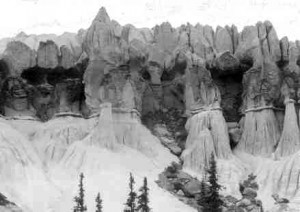Review by Martha Quillen
Anasazi Novel – February 2000 – Colorado Central Magazine
Thunderhead
by Douglas Preston and Lincoln Child
Published in 1999 by Warner Books, Inc.
ISBN 0-446-52337-2
THIS BOOK FLINGS ADVENTURE, Hollywood style — fast and furiously — and starts with such a hodgepodge of bizarre characters behaving implausibly that I almost tossed it aside.
But this particular adventure tale is about the Anasazi, and since the romantic notions that many moderns assign to the Ancient Ones has always eluded me, I decided to stick it out.
Certainly, I’m impressed by the Anasazi. The endurance of their buildings is astonishing, and their roads and cities were truly remarkable. Yet even so, Mesa Verde and Chaco Canyon also serve as testimony to the hardships that must have encumbered the Ancient Ones’ daily existence.
Performing stoop labor under the desert sun and living in cramped, crowded condos with rooms smaller than the worst offerings of New York City tenements — in a place where building materials, water, food and supplies had to be hand-carried up steep, narrow trails — strikes me as a rather unpleasant existence. As I see it, nineteenth century Utes and Pueblos had far more comfortable lifestyles (the Pueblos with their smaller villages, and the Utes with their wandering ways).
But the ancient Egyptians probably didn’t have very cushy lifestyles either, yet decades of Hollywood movies have lent their story a wondrously mystical allure that entirely eclipses any evidence of tedium and drudgery.
So I picked up Thunderhead hoping it would give me what those impressive Anasazi ruins had not — the romantic view.
The first eight or ten chapters of the book, however, were merely ridiculous. All in all, the first 75 pages of Thunderhead exhibit less verisimilitude than Bill Clinton claiming he’s working on his marriage.
Heroine Nora Kelly wants to find the ancient city of Quivera, but something weird is trying to stop her. Actually, those weird somethings are man-dogs, that talk, claw, and growl at her — then lope alongside her speeding pickup.
To make matters worse, in the book’s early chapters neither Nora nor her sidekick brother seem to be very likable characters.
But if you stick with it, the story improves dramatically.
Authors Preston and Child weave a story around modern archeological theories about the Anasazi, and instill it with characters determined to prove their own differing theories on what really happened to those ancient builders.
The adventure soars as Kelly’s expedition treks into the bleak — almost impassable — canyon country beyond the Kaiparowits Plateau in Arizona. As the going gets rough, the players argue more and more. But no one wants to turn back (except the poor wrangler in charge of the horses).
In this tale, the authors meld murder, mayhem — and all of the theories about how Toltecs, cannibalism, drought, and societal disintegration led to the ultimate disappearance of the Anasazi — into a conclusion that explains absolutely everything.
— So did I find what I was looking for in Thunderhead?
— Yeah, I think I did. This tale does tend to amplify the romance of ancient Anasazi ruins.
In real life, when I stand overlooking the sites of ancient cities, I’m always struck by the sad realization that I cannot really know or understand the people who built those cities so long ago. And I suspect that all of the theories — whether they portray the Anasazi as pastoral, democratic and idyllic, or tortured, cannibalistic, and terrorized — merely exacerbate my sense of frustration. Museum dioramas of women grinding corn just don’t reveal much about who people really were — any more than modern pictures of women running food processors would.
But authors Preston and Child build their tale on exactly that: the mystery of the Anasazi. They present a multitude of facts about Anasazi ruins, pottery, shards, petroglyphs, artifacts, and roads. But they delight in the fact that — in spite of all of this evidence — the Anasazi are still essentially unknown and unknowable.
The allure of Thunderhead lies in the appeal of unearthing ancient mysteries, and in the authors’ portrayal of the land — as terrifyingly dry, broken, wild, intimidating and formidable.
In the end, heroine Nora Kelly finally discovers — once and for all — the whole truth about what really happened to the Anasazi. But that’s what’s great about fiction; it can offer the resolutions real life seldom reveals.
What’s great about Thunderhead — in spite of some improbable characters, unbelievable passages, and sheer death-defyingly ridiculous exploits — is that it revels in the romance of discovery. And in the long run, fiction may encompass the greater truth: that our notions of those who came before us probably say more about us than they do about them, anyway.
— Martha Quillen

